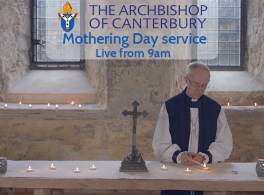Services like Morning and Evening Prayer, Prayer during the Day, and Night Prayer are designed so that they can be said by individuals or in a group. These services and guidance for using them can be found here.
But we may often wish to pray by ourselves as we try to share in Christ's prayer to his Father. Whether you are a child, young person or an adult, prayer is easier than you might imagine! Millions of people of every age pray every day.
Remember that God hears every prayer—but not all prayers are answered in the way we might expect or desire: we don't always pray for his will to be done! Prayer is a discipline - it can be difficult at times, just like keeping fit, being on a diet, or keeping weeds down in the garden. Little and often is best, but don't give up! No prayer, however inadequate you may feel it to be, is ever wasted or of no value.
When should I pray?
Traditionally, prayer times have been morning and evening, but you can choose a time which is best for you. It helps to be somewhere quiet, where you can have some time for yourself.
What do I need?
You might like to set up a special place in which you pray regularly. You might also place an open Bible, a cross, a candle, an icon or another picture, to give the time and space special significance.
You don't have to know any prayers if you want to pray - in fact, words can often get in the way. But you may wish to write down or memorise some prayers that speak to you, especially the Lord’s Prayer. You could build up a collection of favourite prayers and sayings and keep a scrapbook. Or you could use a collection of prayers such as Pocket Prayers or Words for Worship.
Do I have to kneel?
Kneeling is the traditional posture for penitence and standing for praise, but you can pray anywhere - walking, standing, sitting, whatever feels comfortable.
Structure
Sometimes we need to offer ‘arrow prayers’, asking for God’s immediate help in a particular situation. But thankfully we don't live all our lives in moments of extreme crisis. What about day-to-day praying?
Use your hand as a model
Your fingers can be used to bring to mind different things to pray for.
- Thumb
This is the strongest digit on your hand. Give thanks for all the strong things in your life, like home and family, relationships that support and sustain you. - Index finger
This is the pointing finger. Pray for all those people and things in your life who guide and help you. Friends, teachers, doctors, nurses, emergency services and so on. - Middle finger
This is the tallest finger. Pray for all the important people who have power in the world, like world leaders and their governments, members of parliament and local councillors, the Royal Family, other world leaders and their governments. - Ring finger
This is the weakest finger on your hand. It can’t do much by itself. Remember the poor, the weak, the helpless, the hungry, the sick, the ill and the bereaved. - Little finger
This is the smallest and the last finger on your hand. Pray for yourself.
Find a prayer that speaks to you and meditate on each word one by one
For instance the Jesus Prayer: ‘Lord Jesus Christ, Son of God, have mercy on me, a sinner’.
Read a psalm
The Common Worship Psalter gives prayers after each psalm.
Use a prayer book
Time To Pray or The Book of Common Prayer to give you some ideas, or use its prayers as a basis for your own.




